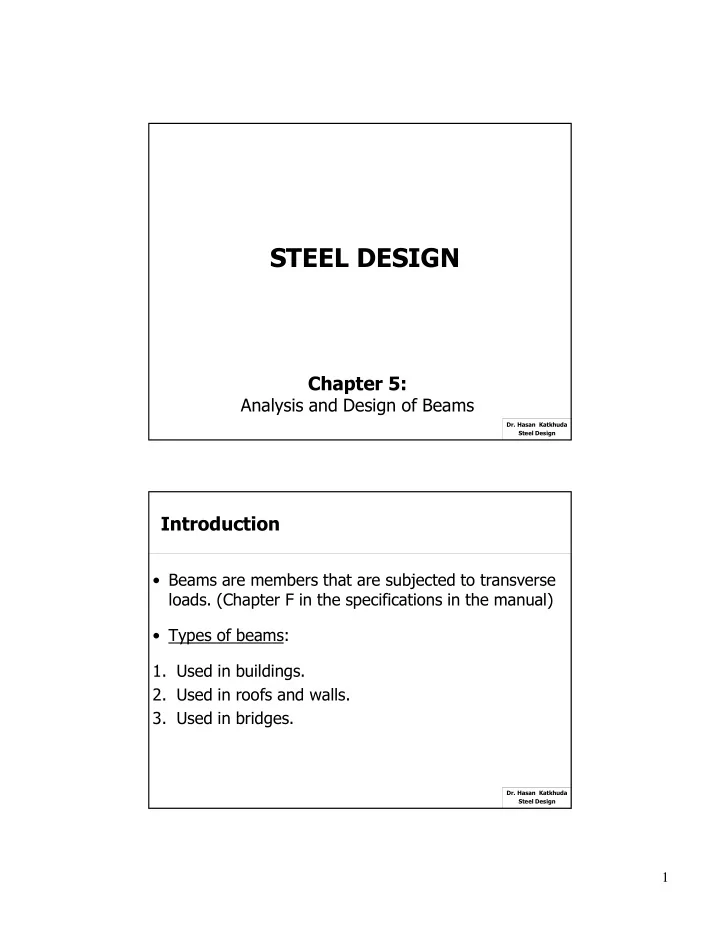

������������� ������������ Analysis and Design of Beams ��������������������� ������������� ������������� • Beams are members that are subjected to transverse loads. (Chapter F in the specifications in the manual) • Types of beams: 1. Used in buildings. 2. Used in roofs and walls. 3. Used in bridges. ��������������������� ������������� 1
������������� 1. Used in buildings: A. Joists: Closely spaced beams supporting floors of buildings. B. Lintels: On top of doors and windows. C. Spandrel beams: To support external walls. ��������������������� ������������� ������������� 2. Used in roofs and walls: A. Purlins: on roofs. B. Girts: on walls. 3. Used in bridges: A. Stringers: beams running parallel to the roadway. B. Floor beams: large beams which are perpendicular to the roadway. ��������������������� ������������� 2
������������� • Types of sections: 1. Rolled steel sections: • W (most economical, used in this class), S, C, T, L. 2. Built up sections: • Plate girder. ��������������������� ������������� ������������� • If h/tw < 5.70 (E/Fy) 0.5 : It is considered beam. • If h/tw > 5.70 (E/Fy) 0.5 : It is considered plate girder ��������������������� ������������� 3
�����!���������!������"�������������� ���� #������� 1. Elastic beam theory: • Plane section before bending remains plane after bending. ��������������������� ������������� �����!���������!������"�������������� ���� #������� 2. Increasing Load (Moment), reaching yielding: • Reaches yield stress and strain. • Still linear. • Sx : Section modulus (I/c) ��������������������� ������������� 4
�����!���������!������"�������������� ���� #������� 3. Increasing Load (Moment), beyond yielding: • Elastic zone (core). • Plastic zone. ��������������������� ������������� �����!���������!������"�������������� ���� #������� 4. Plastic moment (Mp): • Strain and stress reach yielding every where. • Full Plastic zone, Pu, Mp. • Formation of plastic hinge. ��������������������� ������������� 5
�����!���������!������"�������������� ���� #������� ��������������������� ������������� �����!���������!������"�������������� ���� #������� ��������������������� ������������� 6
�����!���������!������"�������������� ���� #������� ��������������������� ������������� �$�%����� • Example 1: A572, Grade 50. Determine: 1. Yielding moment and elastic section modulus. 2. Plastic moment and plastic section modulus. ��������������������� ������������� 7
�$�%����� 1. . ��������������������� ������������� �$�%����� 2. . ��������������������� ������������� 8
�$�%����� 2. . ��������������������� ������������� �$�%����� • Example 2: • Determine plastic section modulus. ��������������������� ������������� 9
�$�%����� ��������������������� ������������� #�������!��������� 1. Lateral Torsional Buckling (LTB): ��������������������� ������������� 10
#�������!��������� • Mn = Mp (if the beam remains stable up to the fully plastic condition) ��������������������� ������������� #�������!��������� • Lateral torsional buckling will not occur if the compression flange of a member is braced or if twisting of the beam is prevented at frequent intervals. • Two Categories of lateral support: 1. Continuous lateral support by embedment of the compression flange in a concrete slab. 2. Lateral support at short or long intervals. ��������������������� ������������� 11
#�������!��������� 2. Classifications of Shapes : A. Compact sections: • Capable of developing a fully plastic stress distribution before buckling. • If λ < λp and the flange is continuously connected to the web. B. NonB Compact sections: • Yield stress can be reached in some but not all of the elements. • If λp < λ < λr ��������������������� ������������� #�������!��������� C. Slender sections: • If λ > λr ��������������������� ������������� 12
#�����������������!���%������������ • Beams can fail by reaching Mp and become fully plastic , or it can fail by: 1. Lateral Torsional Buckling (LTB), elastic or inelastic. 2. Flange Local Buckling (FLB), elastic or inelastic. 3. Web Local Buckling (WLB), elastic or inelastic. ��������������������� ������������� #�����������������!���%������������ ��������������������� ������������� 13
#�����������������!���%������������ 1. Plastic Behavior ( Zone 1): • Compact Shape. • Compression flange is continuously braced laterally or lateral bracing are provided at short intervals, i.e. Lb > Lp • Where • , φb =0.9 ��������������������� ������������� #�����������������!���%������������ • For bending about minor axis (yBy); there is no (LTB) in the doubly symmetrical sections. • Always zone 1. • Φb Mn = φb Mp = φb Fy Zy < φb 1.6 Fy Sy ��������������������� ������������� 14
�$�%�����&'����()� • Example 1: • W16 x 31, A992 steel. • Continuous Lateral Support. • Is the beam adequate in flexure? ��������������������� ������������� �$�%�����&'����()� ��������������������� ������������� 15
�$�%�����&'����()� ��������������������� ������������� �$�%�����&'����()� • Example 2: • Fy = 50 ksi. • Continuous lateral support. • Design. ��������������������� ������������� 16
�$�%�����&'����()� • Case 1 + Case 9 Table 3B23 in the manual. ��������������������� ������������� �$�%�����&'����()� • Case 1 + Case 9 Table 3B23 in the manual. ��������������������� ������������� 17
Recommend
More recommend